 What have been, and will be, the monetary and fiscal responses to the Brexit vote in the referendum of 23 June 2016? This question has been addressed in speeches by Mark Carney, Governor of the Bank of England, and by George Osborne, Chancellor the Exchequer. Both recognise that the vote will cause a negative shock to the economy, which will require some stimulus to aggregate demand to avoid a recession, or at least minimise its depth.
What have been, and will be, the monetary and fiscal responses to the Brexit vote in the referendum of 23 June 2016? This question has been addressed in speeches by Mark Carney, Governor of the Bank of England, and by George Osborne, Chancellor the Exchequer. Both recognise that the vote will cause a negative shock to the economy, which will require some stimulus to aggregate demand to avoid a recession, or at least minimise its depth.
Mark Carney stated that:
The Bank of England stands ready to provide more than £250bn of additional funds through its normal facilities. The Bank of England is also able to provide substantial liquidity in foreign currency, if required.
In the coming weeks, the Bank will assess economic conditions and will consider any additional policy responses.
This could mean that at its the next meeting, scheduled for 13/14 July, the Monetary Policy Committee will consider reducing Bank Rate from its current level of 0.5% and introducing further quantitative easing.
In a speech on 30 June, he went further:
I can assure you that in the coming months the Bank can be expected to take whatever action is needed to support growth subject to inflation being projected to return to the target over an appropriate horizon, and inflation expectations remaining well anchored.
Then in a speech on 5 July, introducing the latest Financial Stability Report, he said that the Bank of England’s Financial Policy Committee is lowering the required capital ratio of banks, thereby freeing up capital for lending to customers. The part being lowered is the ‘countercyclical capital buffer’ – the element that can be varied according to the state of the economy. Mark Carney said:
The FPC is today reducing the countercyclical capital buffer on banks’ UK exposures from 0.5% to 0% with immediate effect. This is a major change. It means that three quarters of UK banks, accounting for 90% of the stock of UK lending, will immediately have greater flexibility to supply credit to UK households and firms.
Specifically, the FPC’s action immediately reduces regulatory capital buffers by £5.7 billion and therefore raises banks’ capacity to lend to UK businesses and households by up to £150 billion. For comparison, last year with a fully functioning banking system and one of the fastest growing economies in the G7, total net lending in the UK was £60 billion.
Thus although there may be changes to interest rates and narrow money in response to economic reactions to the Brexit vote, the monetary policy framework remains unchanged. This is to achieve a target rate of CPI inflation of 2% at the 24-month time horizon.
 But what of fiscal policy?
But what of fiscal policy?
In its Charter for Budget Responsibility, updated in the Summer 2015 Budget, the government states its Fiscal Mandate:
3.2 In normal times, once a headline surplus has been achieved, the Treasury’s mandate for fiscal policy is:
• a target for a surplus on public-sector net borrowing in each subsequent year.
3.3 For the period outside normal times from 2015-16, the Treasury’s mandate for fiscal policy is:
• a target for a surplus on public-sector net borrowing by the end of 2019-20.
3.4 For this period until 2019-20, the Treasury’s mandate for fiscal policy is supplemented by:
• a target for public-sector net debt as a percentage of GDP to be falling in each year.
The target of a PSNB surplus by 2019-20 has been the cornerstone of recent fiscal policy. In order to stick to it, the Chancellor warned before the referendum that a slowdown in the economy as a result of a Brexit vote would force him to introduce an emergency Budget, which would involve cuts in government expenditure and increases in taxes.
 However, since the vote he is now saying that the slowdown would force him to extend the time for reaching a surplus beyond 2019-20 to avoid dampening the economy further. But does this mean he is abandoning his fiscal target and resorting to discretionary expansionary fiscal policy?
However, since the vote he is now saying that the slowdown would force him to extend the time for reaching a surplus beyond 2019-20 to avoid dampening the economy further. But does this mean he is abandoning his fiscal target and resorting to discretionary expansionary fiscal policy?
George Osborne’s answer to this question is no. He argues that extending the deadline for a surplus is consistent with paragraph 3.5 of the Charter, which reads:
3.5 These targets apply unless and until the Office for Budget Responsibility (OBR) assess, as part of their economic and fiscal forecast, that there is a significant negative shock to the UK. A significant negative shock is defined as real GDP growth of less than 1% on a rolling 4 quarter-on-4 quarter basis. If the OBR assess that a significant negative shock:
|
|
| • |
occurred in the most recent 4 quarter period; |
| • |
is occurring at the time the assessment is being made; or |
| • |
will occur during the forecast period |
then:
|
|
| • |
if the normal times surplus rule in 3.2 is in force, the target for a surplus each year is suspended (regardless of future data revisions). The Treasury must set out a plan to return to surplus. This plan must include appropriate fiscal targets, which will be assessed by the OBR. The plan, including fiscal targets, must be presented by the Chancellor of the Exchequer to Parliament at or before the first financial report after the shock. The new fiscal targets must be approved by a vote in the House of Commons. |
| • |
if the shock occurs outside normal times, the Treasury will review the appropriateness of its fiscal targets for the period until the public finances return to surplus. Any changes to the targets must be approved by a vote in the House of Commons. |
| • |
once the budget is in surplus, the target set out in 3.2 above applies. |
In other words, if the OBR forecasts that the Brexit vote will result in GDP growing by less than 1%, the Chancellor can delay reaching the surplus and thus not have to introduce tougher austerity measures. This, in effect, is what he is now saying and maintaining that, because of paragraph 3.5, it does not break the Fiscal Mandate. The nature of the next Budget, probably in the autumn, will depend on OBR forecasts.
A few days later, George Osborne announced that he plans to cut corporation tax from the current 20% to less than 15% – below the rate of 17% previously scheduled for 2019-20. His aim is not just to stimulate the economy, but to attract inward investment, as the rate would below that of any major economy and close the rate of 12.5% in Ireland. His hope would also be to halt the outflow of investment as companies seek to relocate in the EU.
Videos and podcasts
 Statement from the Governor of the Bank of England following the EU referendum result Bank of England (24/6/16)
Statement from the Governor of the Bank of England following the EU referendum result Bank of England (24/6/16)
 Uncertainty, the economy and policy – speech by Mark Carney Bank of England (30/6/16)
Uncertainty, the economy and policy – speech by Mark Carney Bank of England (30/6/16)
 Introduction to Financial Stability Report, July 2016 Bank of England (5/7/16)
Introduction to Financial Stability Report, July 2016 Bank of England (5/7/16)
 Osborne: Life will not be ‘economically rosy’ outside EU BBC News (28/6/16)
Osborne: Life will not be ‘economically rosy’ outside EU BBC News (28/6/16)
 Osborne takes ‘realistic’ view over surplus target BBC News (1/7/16)
Osborne takes ‘realistic’ view over surplus target BBC News (1/7/16)
 Why has George Osborne abandoned a key economic target? BBC News (1/7/16)
Why has George Osborne abandoned a key economic target? BBC News (1/7/16)
Articles
Mark Carney says Bank of England ready to inject £250bn into economy to keep UK afloat after EU referendum Independent, Zlata Rodionova (24/6/16)
Carney Signals Rate Cuts as Brexit Chaos Engulfs Political Class Bloomberg, Scott Hamilton (30/6/16)
Bank of England hints at UK interest rate cuts over coming months to ease Brexit woes International Business Times, Gaurav Sharma (30/6/16)
Carney prepares for ‘economic post-traumatic stress’ Financial Times, Emily Cadman (30/6/16)
Bank of England warns Brexit risks beginning to crystallise BBC News (5/7/16)
Bank of England tells banks to cut buffer to boost lending Financial Times, Caroline Binham and Chris Giles (5/7/16)
George Osborne puts corporation tax cut at heart of Brexit recovery plan Financial Times (3/7/16)
George Osborne corporation tax cut is the wrong way to start EU negotiations, former WTO boss says Independent, Hazel Sheffield (5/7/16)
George Osborne abandons 2020 UK surplus target Financial Times, Emily Cadman and Gemma Tetlow (1/7/16)
George Osborne scraps 2020 budget surplus plan The Guardian, Jill Treanor and Katie Allen (1/7/16)
Osborne abandons 2020 budget surplus target BBC News (1/7/16)
Brexit and the easing of austerity BBC News, Kamal Ahmed (1/7/16)
Osborne Follows Carney in Signaling Stimulus After Brexit Bloomberg, Simon Kennedy (1/7/16)
Questions
- Explain the measures taken by the Bank of England directly after the Brexit vote.
- What will determine whether the Bank of England engages in further quantitative easing beyond the current £385bn of asset purchases?
- How does monetary policy easing (or the expectation of it) affect the exchange rate? Explain.
- How effective is monetary policy for expanding aggregate demand? Is it more or less effective than using monetary policy to reduce aggregate demand?
- Explain what is meant by (a) capital adequacy ratios (tier 1 and tier 2); (b) countercyclical buffers. (See, for example, Economics 9th edition, page 533–7 and Figure 16.2))
- To what extent does increasing the supply of credit result in that credit being taken up by businesses and consumers?
- Distinguish between rules-based and discretionary fiscal policy. How would you describe paragraph 3.5 in the Charter for Budget Responsibility?
- Would you describe George Osborne’s proposed fiscal measures as expansionary or merely as less contractionary?
- Why is the WTO unhappy with George Osborne’s proposals about corporation tax?
- What is the Nash equilibrium of countries seeking to undercut each other’s corporation tax rates?
 In April we asked how sustainable is the UK’s appetite for credit? Data in the latest Bank of England’s Money and Credit publication suggest that such concerns are likely grow. It shows net lending (lending net of repayments) by monetary financial institutions (MFIs) to individuals in March 2016 was £9.3 billion, the highest monthly total since August 2007. This took net borrowing over the previous 12 months to £58.6 billion, the highest 12-month figure since September 2008.
In April we asked how sustainable is the UK’s appetite for credit? Data in the latest Bank of England’s Money and Credit publication suggest that such concerns are likely grow. It shows net lending (lending net of repayments) by monetary financial institutions (MFIs) to individuals in March 2016 was £9.3 billion, the highest monthly total since August 2007. This took net borrowing over the previous 12 months to £58.6 billion, the highest 12-month figure since September 2008.
The latest credit data raise fears about the impact on the financial well-being of individuals. The financial well-being of people, companies, banks and governments can have dramatic effects on economic activity. These were demonstrated vividly in the late 2000s when a downturn resulted from attempts by economic agents to improve their financial well-being. Retrenchment led to recession. Given the understandable concerns about financial distress we revisit our April blog.
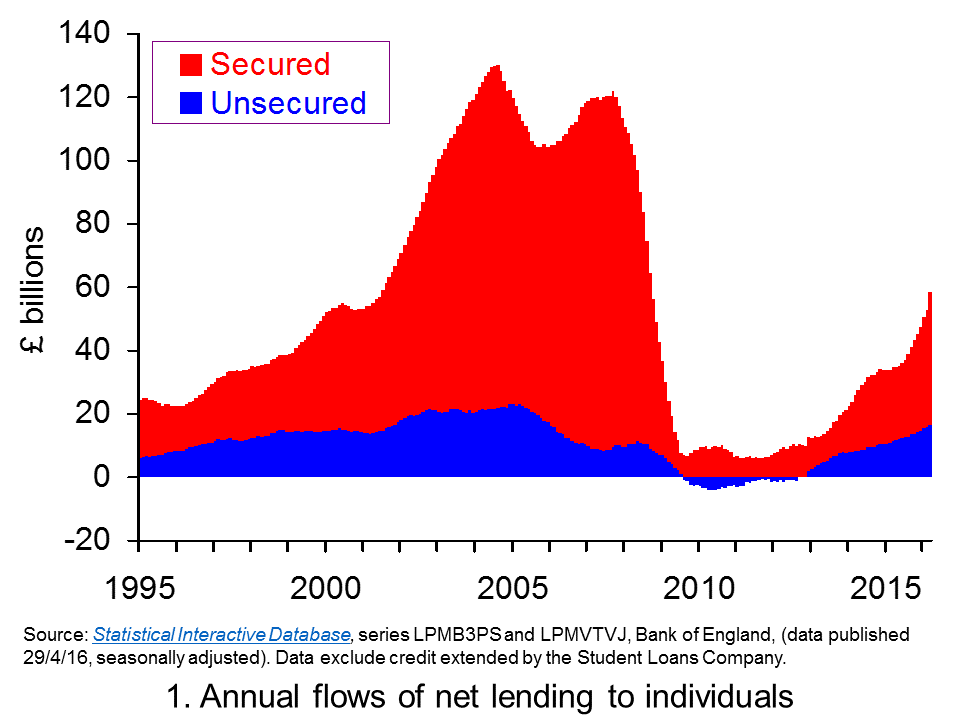 Chart 1 shows the annual flow of lending extended to individuals, net of repayments. (Click here to download a PowerPoint of Chart 1.) The chart provides evidence of cycles both in secured lending and in consumer credit (unsecured lending).
Chart 1 shows the annual flow of lending extended to individuals, net of repayments. (Click here to download a PowerPoint of Chart 1.) The chart provides evidence of cycles both in secured lending and in consumer credit (unsecured lending).
The growth in net lending during the 2000s was stark as was the subsequent squeeze on lending that followed. During 2004, for example, annual net flows of lending from MFIs to individuals exceeded £130 billion, the equivalent of close on 10.5 per cent of annual GDP. Secured lending was buoyed by strong house price growth with UK house price inflation rising above 14 per cent. Nonetheless, consumer credit was very strong too equivalent to 1.8 per cent of GDP.
Net lending collapsed following the financial crisis. In the 12 months to March 2011 the flow of net lending amounted to just £3.56 billion, a mere 0.2 per cent of annual GDP. Furthermore, net consumer credit was now negative. In other words, repayments were exceeding new sums being extended by MFIs.

Clearly, as Chart 1 shows, net lending to individuals is again on the rise. This partly reflects a rebound in sections of the UK housing market. Net secured lending in March was £7.435 billion, the highest monthly figure since November 2007. Over the past 12 months net secured lending has amounted to £42.1 billion, the highest 12-month figure since October 2008.
Yet the growth of unsecured credit has been even more spectacular. In March net consumer credit was £1.88 billion (excluding debt extended by the Student Loans Company). This is the highest month figure since March 2005. It has taken the amount of net consumer credit extended to individuals over the past 12 months to £16.435 billion, the highest figure since December 2005.
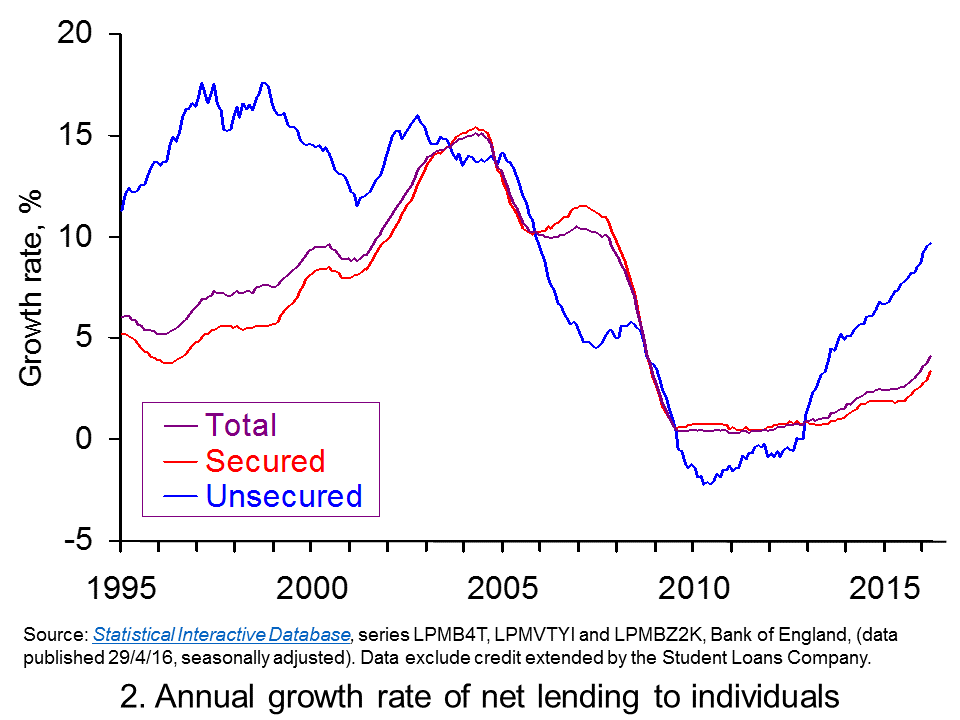 Chart 2 shows the annual growth rate of both forms of net lending by MFIs. In essence, this mirrors the growth rate in the stocks of debt – though changes in debt stocks can also be affected by the writing off of debts. The chart captures the very strong rates of growth in net unsecured lending from MFIs. We are now witnessing the strongest annual rate of growth in consumer credit since November 2005. (Click here to download a PowerPoint of the chart.)
Chart 2 shows the annual growth rate of both forms of net lending by MFIs. In essence, this mirrors the growth rate in the stocks of debt – though changes in debt stocks can also be affected by the writing off of debts. The chart captures the very strong rates of growth in net unsecured lending from MFIs. We are now witnessing the strongest annual rate of growth in consumer credit since November 2005. (Click here to download a PowerPoint of the chart.)
The growth in household borrowing, especially that in consumer credit, evidences the need for individuals to be mindful of their financial well-being. Given that these patterns are now becoming well-established you can expect to see considerable comment in the months ahead about our appetite for credit. Can such an appetite for borrowing be sustained without triggering a further balance sheet recession as experienced at the end of the 2000s?
Articles
Consumer credit rises at fastest pace for 11 years The Guardian, Hilary Osborne (29/4/16)
Debt bubble fears increase as consumer credit soars to 11-year high The Telegraph, Szu Ping Chan (29/4/16)
Fears of households over-stretching on borrowing as consumer credit grows The Scotsman, (29/4/16)
History repeating? Fears of another financial crisis as borrowing reaches 11-year high Sunday Express, Lana Clements (29/4/16)
The chart that shows we put more on our credit cards in March than in any month in 11 years Independent, Ben Chu (1/4/16)
Britain’s free market economy isn’t working The Guardian (13/1/16)
Data
Money and Credit – March 2016 Bank of England
Bankstats (Monetary and Financial Statistics) – Latest Tables Bank of England
Statistical Interactive Database Bank of England
Questions
- What does it mean if individuals are financially distressed?
- How would we measure the financial well-being of individuals and households?
- What actions might individuals take it they are financially distressed? What might the economic consequences be?
- How might uncertainty affect spending and saving by households?
- What measures can policymakers take to reduce the likelihood that flows of credit become too excessive?
- What is meant by a balance sheet recession?
- Explain the difference between secured debt and unsecured debt.
- Should we be more concerned about the growth of consumer credit than secured debt?
 In a recent post, Global Warning, we looked at concerns about the global economy. One of these was about the ineffectiveness of monetary policy to stimulate aggregate demand and to restore growth rates. Despite the use of unconventional monetary policies, such as quantitative easing and negative interest rates, and despite the fact that these policies have become the new convention, they have failed to do enough to bring sustained recovery.
In a recent post, Global Warning, we looked at concerns about the global economy. One of these was about the ineffectiveness of monetary policy to stimulate aggregate demand and to restore growth rates. Despite the use of unconventional monetary policies, such as quantitative easing and negative interest rates, and despite the fact that these policies have become the new convention, they have failed to do enough to bring sustained recovery.
The two articles below argue that the failure has been due to a flawed model of monetary policy: one that takes too little account of the behaviour of banks and the drivers of consumption and of physical investment. Negative interest rates on banks’ holdings of reserves in central banks are hardly likely to push down lending rates to businesses sufficiently to stimulate investment in new plant and machinery if firms already have overcapacity. And consumers are unlikely to borrow more for consumption if their wages are barely rising and they already have debts that they fear will be difficulty to pay off.
As Joseph Stiglitz points out:
As real interest rates have fallen, business investment has stagnated. According to the OECD, the percentage of GDP invested in a category that is mostly plant and equipment has fallen in both Europe and the US in recent years. (In the US, it fell from 8.4% in 2000 to 6.8% in 2014; in the EU, it fell from 7.5% to 5.7% over the same period.) Other data provide a similar picture.
And the unwillingness of many firms and individuals to borrow is matched by banks’ caution about lending in an uncertain economic environment. Many are more concerned about building their capital and liquidity ratios to protect themselves. In these circumstances, negative interest rates have little effect on stimulating bank lending and, by hurting their balance sheets through lower earnings on the money markets, may even encourage them to lend less
In these circumstances, negative interest rates have little effect on stimulating bank lending and, by hurting their balance sheets through lower earnings on the money markets, may even encourage them to lend less
What central banks should be doing, argue both Stiglitz and Elliott, is finding ways of directly stimulating consumption and investment. Perhaps this will involve central banks “focusing on the flow of credit, which means restoring and maintaining local banks’ ability and willingness to lend to SMEs.” Perhaps it will mean using helicopter money, as we examined in the previous blog. As Larry Elliott points out:
The fact that economists at Deutsche Bank published a helpful cut-out-and-keep guide to helicopter  money last week is a straw in the wind.
money last week is a straw in the wind.
As the Deutsche research makes clear, the most basic variant of helicopter money involves a central bank creating money so that it can be handed to the finance ministry to spend on tax cuts or higher public spending. There are two differences with QE. The cash goes directly to firms and individuals rather than being channelled through banks, and there is no intention of the central bank ever getting it back.
So if the model of monetary policy is indeed flawed, prepare for more unconventional measures
Articles
What’s Wrong With Negative Rates?, Project Syndicate, Joseph Stiglitz (13/4/16)
The bad smell hovering over the global economy The Guardian, Larry Elliott (17/4/16)
Questions
- What arguments does Stiglitz use to support his claim that the model of monetary policy currently being used is flawed?
- In what ways has monetary policy hurt older people and what has been the effect on their spending and on aggregate demand in general?
- Why has monetary policy encouraged investors to shift their portfolios toward riskier assets?
- Examine the argument that ultra-low interest rates may result in a rise in unemployment in the long term by affecting the relative prices of capital and labour.
- What forms might helicopter money take?
- Would the use of helicopter money necessarily result in an increase in aggregate demand? What would determine the size of any such increase?
 The latest Bank of England’s Money and Credit release shows net lending (lending net of repayments) by Monetary Financial Institutions (MFIs) to individuals in February was £4.9 billion. Although down on the £5.4 billion in January, it nonetheless means that over the last 12 months the flow of net lending amounted to £52.8 billion. This is the highest 12-month figure since October 2008.
The latest Bank of England’s Money and Credit release shows net lending (lending net of repayments) by Monetary Financial Institutions (MFIs) to individuals in February was £4.9 billion. Although down on the £5.4 billion in January, it nonetheless means that over the last 12 months the flow of net lending amounted to £52.8 billion. This is the highest 12-month figure since October 2008.
The latest credit data raise concerns about levels of lending and their potential to again impact on the financial well-being of individuals, particularly in light of the falling proportion of income that households are saving. As we saw in UK growth fuelled by consumption as households again lose affection for their piggy banks the saving ratio fell to an historic low of 4.2 per cent for 2015.
An important factor affecting the financial well-being of individuals and households is the extent of their indebtedness. Flows of credit accumulate to become stocks of debt. Stocks of debt affect the extent to which household incomes becomes prey to debt servicing costs. Put simply, more and more income, all other things being equal, is needed for interest payments and capital repayments as debt stocks rise. Rising stocks of debt can also affect the ability of people to further fund borrowing, particularly if debt levels grow more quickly than asset values, such as the value of financial assets accumulated through saving. Consequently, the growth of debt can result in households incurring what is called balance sheet congestion with deteriorating financial well-being or increased financial stretch.
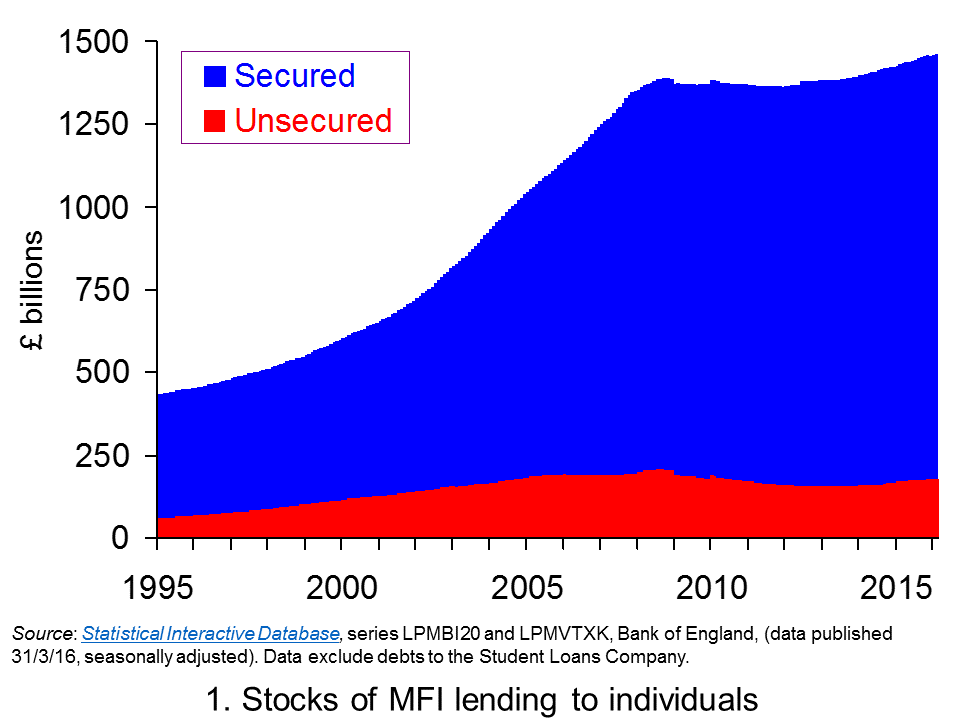 Chart 1 shows the stocks of debt acquired by individuals from MFIs, i.e. deposit-taking financial institutions. It shows both secured debt stocks (mortgage debt) and unsecured debt stocks (consumer credit). The scale of debt accumulation, particularly from the mid 1990s up to the financial crisis of the late 2000s is stark.
Chart 1 shows the stocks of debt acquired by individuals from MFIs, i.e. deposit-taking financial institutions. It shows both secured debt stocks (mortgage debt) and unsecured debt stocks (consumer credit). The scale of debt accumulation, particularly from the mid 1990s up to the financial crisis of the late 2000s is stark.
At the start of 1995 UK individuals had debts to MFIs of a little over £430 billion, the equivalent of roughly 55 per cent of annual GDP (Gross Domestic Product). By the autumn of 2008 this had hit £1.39 trillion, the equivalent of roughly 90 per cent of annual GDP. At both points around 85 per cent of the debt was secured debt, though around the start of the decade it had fallen back a little to around 80 per cent. (Click here to download a PowerPoint of Chart 1.)
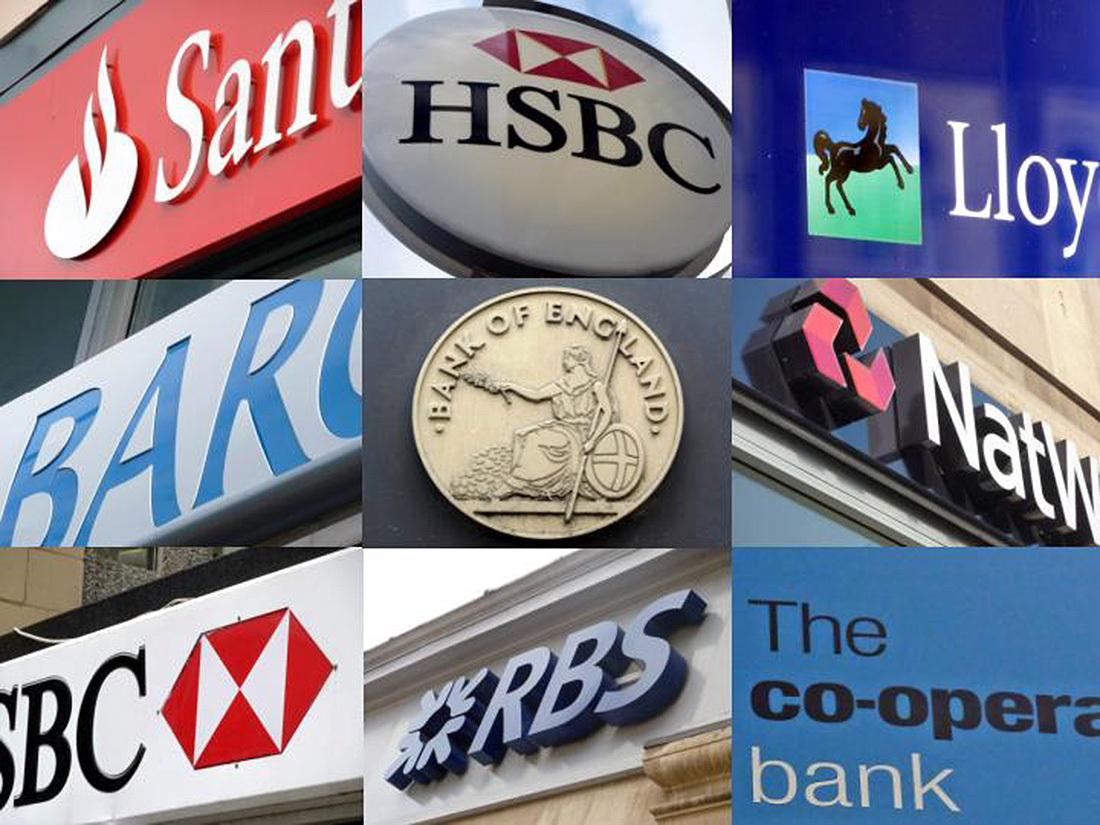
The path of debt at the start of the 2010s is consistent with a story of consolidation. Both financially-distressed individuals and MFIs took steps to repair their balance sheets following the financial crisis. These steps, it is argued, are what resulted in a balance sheet recession. This saw the demand for and supply of additional credit wane. Consequently, as Chart 1 shows debt accumulation largely ceased.
More recently the indebtedness to MFIs of individuals has started to rise again. At the end of February 2014 the stock of debt was just shy of £1.4 trillion. By the end of February 2016 it had risen to £1.47 trillion (a little under 80 per cent of annual GDP). This is an increase of 4.7 per cent. Interestingly, the rise was largely driven by unsecured debt. It rose by 13.4 per cent from £159.4 billion to £180.7 billion. Despite the renewed buoyancy of the housing market, particularly in South East England, the stock of secured debt has risen by just 3.6 per cent from £1.24 trillion to £1.28 trillion.
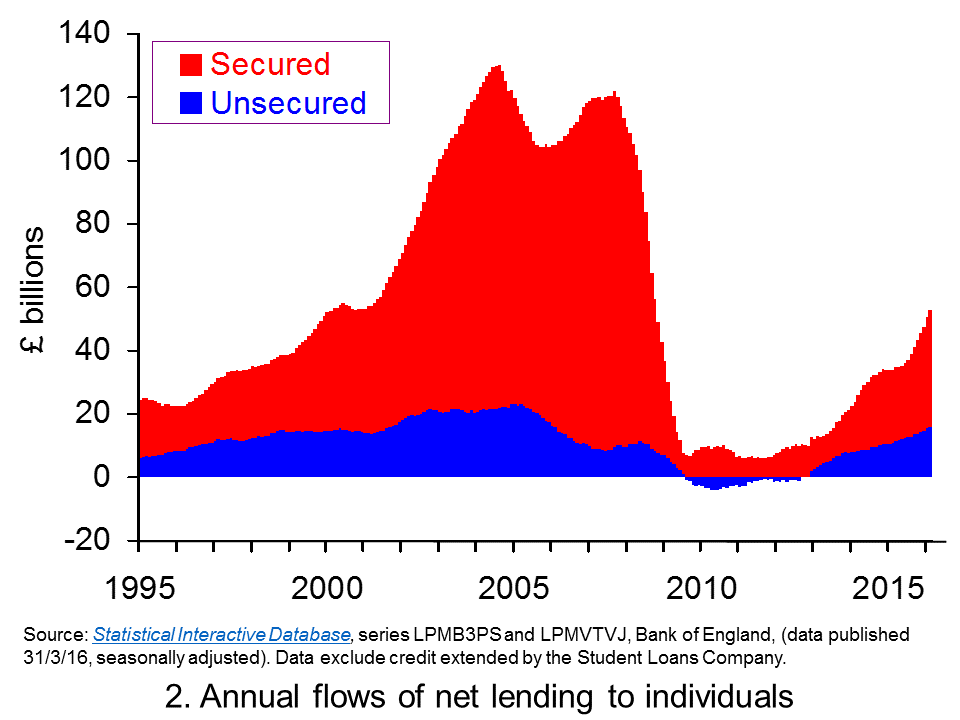 Chart 2 shows the annual flow of lending extended to individuals, net of repayments. (Click here to download a PowerPoint of Chart 2.) The chart provides evidence of cycles both in secured lending and in consumer credit (unsecured lending).
Chart 2 shows the annual flow of lending extended to individuals, net of repayments. (Click here to download a PowerPoint of Chart 2.) The chart provides evidence of cycles both in secured lending and in consumer credit (unsecured lending).
The growth in net lending during the 2000s was stark as was the subsequent squeeze on lending that followed. During 2004, for example, annual net flows of lending from MFIs to individuals exceeded £130 billion, the equivalent of close on 10.5 per cent of annual GDP. Secured lending was buoyed by strong house price growth with UK house price inflation rising above 14 per cent. Nonetheless, consumer credit was very strong too equivalent to 1.8 per cent of GDP.
Net lending collapsed following the financial crisis. In the 12 months to March 2011 the flow of net lending amounted to just £3.56 billion, a mere 0.2 per cent of annual GDP. Furthermore, net consumer credit was now negative. In other words, repayments were exceeding new sums being extended by MFIs.

Clearly, as Chart 2 shows, we can see that net lending to individuals is again on the rise. As we noted earlier, part of this this reflects a rebound in parts of the UK housing market. It is perhaps worth noting that secured lending helps individuals to purchase housing and thereby acquire physical wealth. While secured lending can find its way to fuelling spending, for example, through the purchase of goods and services when people move into a new home, consumer credit more directly fuels spending and so aggregate demand. Furthermore, consumer credit is not matched on the balance sheets by an asset in the same way that secured credit is.
 Chart 3 shows the annual growth rate of both forms of net lending by MFIs. In essence, this mirrors the growth rate in the stocks of debt though changes in the stocks of debt can also be affected by the writing off of debts. What the chart nicely shows is the strong rates of growth in net unsecured lending from MFIs. In fact, it is the strongest annual rate of growth since January 2006 (Click here to download a PowerPoint of the chart.)
Chart 3 shows the annual growth rate of both forms of net lending by MFIs. In essence, this mirrors the growth rate in the stocks of debt though changes in the stocks of debt can also be affected by the writing off of debts. What the chart nicely shows is the strong rates of growth in net unsecured lending from MFIs. In fact, it is the strongest annual rate of growth since January 2006 (Click here to download a PowerPoint of the chart.)
The growth in consumer credit, the fall in the saving ratio and the growth in consumer spending point to a need for individuals to be mindful of their financial well-being. What is for sure, is that you can expect to see considerable comment in the months ahead about consumption, credit and income data. Fundamental to these discussions will be the sustainability of current lending patterns.
Articles
Consumer Lending Growth Highest Since 2005 Sky News, (31/3/16)
Britons raid savings to fund spending as economists warn recovery ‘built on sand’ Telegraph, Szu Ping Chan (31/3/16)
Household debt binge has no end in sight, says OBR Telegraph, Szu Ping Chan (17/3/16)
Surge in borrowing… as savings dwindle: Household savings are at an all-time low as families turn to cheap loans and credit cards Daily Mail, James Burton (1/4/16)
George Osborne banks on household debt time bomb to meet his Budget targets Mirror, Ben Glaze (29/3/16)
Britain’s free market economy isn’t working Guardian (13/1/16)
Data
Bankstats (Monetary and Financial Statistics) – Latest Tables Bank of England
Statistical Interactive Database Bank of England
Questions
- What does it mean if individuals are financially distressed?
- How would we measure the financial well-being of individuals and households?
- What actions might individuals take it they are financially distressed? What might the economic consequences be?
- How might uncertainty affect spending and saving by households?
- What measures can policymakers take to reduce the likelihood that flows of credit become too excessive?
- What is meant by a balance sheet recession?
- Explain the difference between secured debt and unsecured debt.
- Should we be more concerned about the growth of consumer credit than secured debt?
 The latest data in the Quarterly National Accounts show that UK households in 2015 spent £1.152 trillion, the equivalent of 62 per cent of the country’s Gross Domestic Product (GDP). In real terms, household spending rose by 2.8 per cent in 2015 in excess of the 2.3 per cent growth observed in GDP. In the final quarter of 2015 real household spending rose by 0.6 per – the same rate of growth as that recorded for the UK economy. This was the tenth consecutive quarter of positive consumption growth and the twelfth of economic growth.
The latest data in the Quarterly National Accounts show that UK households in 2015 spent £1.152 trillion, the equivalent of 62 per cent of the country’s Gross Domestic Product (GDP). In real terms, household spending rose by 2.8 per cent in 2015 in excess of the 2.3 per cent growth observed in GDP. In the final quarter of 2015 real household spending rose by 0.6 per – the same rate of growth as that recorded for the UK economy. This was the tenth consecutive quarter of positive consumption growth and the twelfth of economic growth.
It is the consistent growth seen over the recent past in real household spending that marks it out from the other components of aggregate demand. Consequently, household spending remains the bedrock of UK growth.
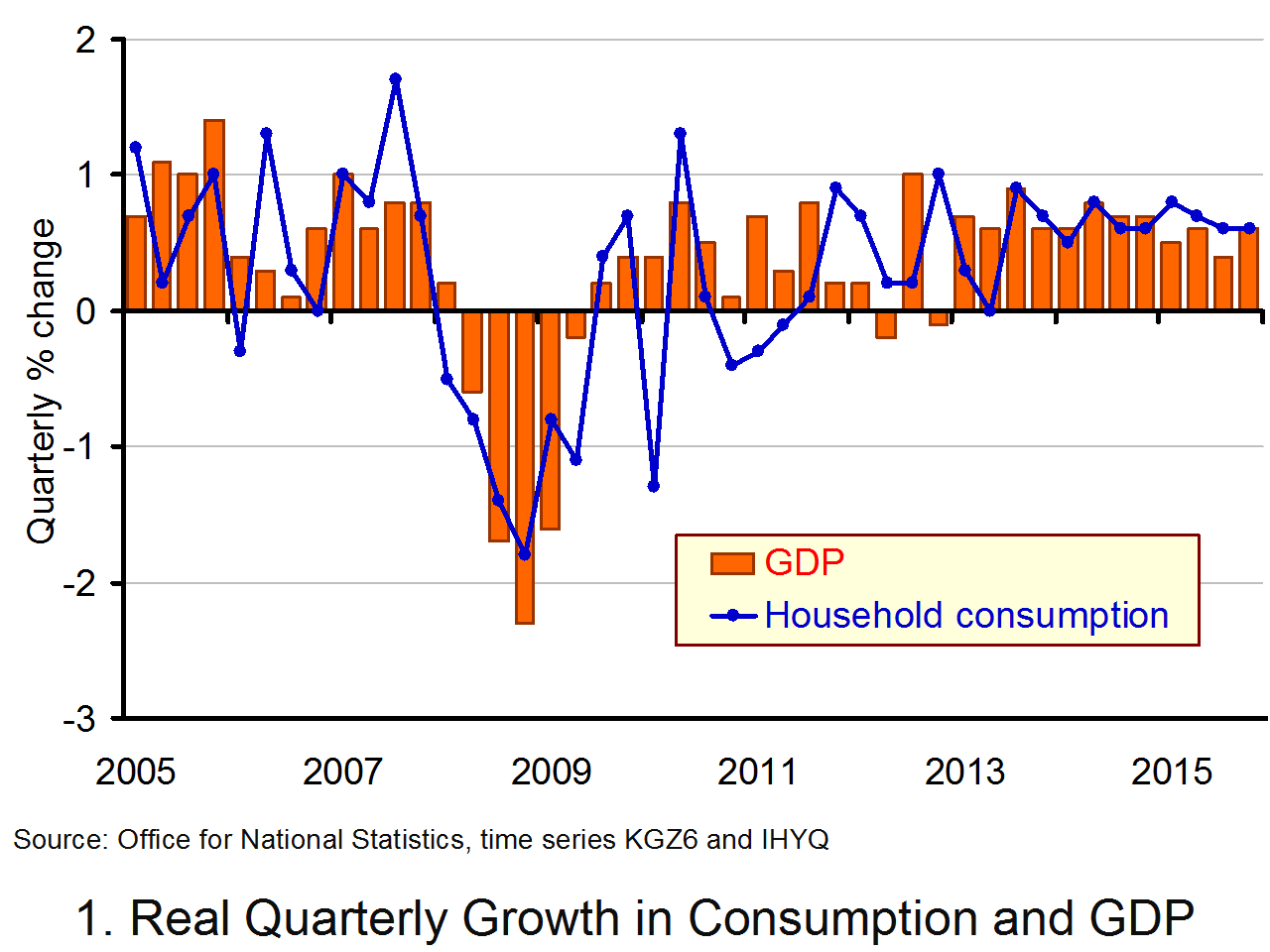 Chart 1 helps to evidence the close relationship between consumption and economic growth. It picks out nicely the stark turnaround both in economic growth and consumer spending following the financial crisis. Over the period from 2008 Q1 to 2011 Q2, real consumer spending typically fell by 0.4 per cent each quarter. This weakness in consumption was mirrored by economic growth. Real GDP contracted over this period by an average of 0.2 per cent each quarter. (Click here to download a PowerPoint of the chart.)
Chart 1 helps to evidence the close relationship between consumption and economic growth. It picks out nicely the stark turnaround both in economic growth and consumer spending following the financial crisis. Over the period from 2008 Q1 to 2011 Q2, real consumer spending typically fell by 0.4 per cent each quarter. This weakness in consumption was mirrored by economic growth. Real GDP contracted over this period by an average of 0.2 per cent each quarter. (Click here to download a PowerPoint of the chart.)
Since 2011 Q3 real consumption growth has averaged 0.6 per cent per quarter – the rate at which consumption grew in 2015 Q4 – while, real GDP growth has averaged 0.5 per cent per quarter. Over this same period the real disposable income (post-tax income) of the combined household and NPISH (non-profit institutions serving households), has typically grown by 0.4 per cent per quarter. (NPISHs are charities and voluntary organisations.)
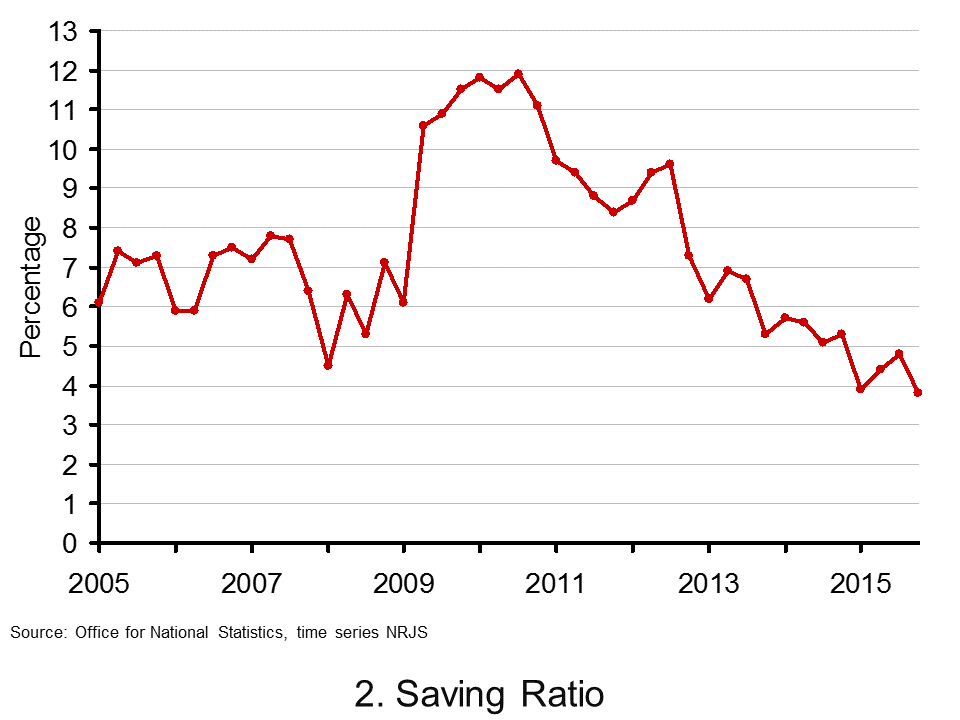 The strength of consumption relative to income is evidenced by the decline in the saving ratio as can be observed in Chart 2. The ratio captures the percentage of disposable income that households (and NPISHs) choose to save. In 2010 Q3 the proportion of income saved hit 11.9 per cent having been as low as 4.5 per cent in 2008 Q1. By 2015 Q4 the saving ratio had fallen to 3.8 per cent, the lowest value since the series began in 1963 Q1. (Click here to download a PowerPoint.)
The strength of consumption relative to income is evidenced by the decline in the saving ratio as can be observed in Chart 2. The ratio captures the percentage of disposable income that households (and NPISHs) choose to save. In 2010 Q3 the proportion of income saved hit 11.9 per cent having been as low as 4.5 per cent in 2008 Q1. By 2015 Q4 the saving ratio had fallen to 3.8 per cent, the lowest value since the series began in 1963 Q1. (Click here to download a PowerPoint.)
The historic low in the saving ratio in the final quarter of 2015 reflects the strength of consumption alongside a sharp fall in real disposable income of 0.6 per cent in the quarter. However, the bigger picture shows a marked downward trend in the saving ratio over the period from 2012.
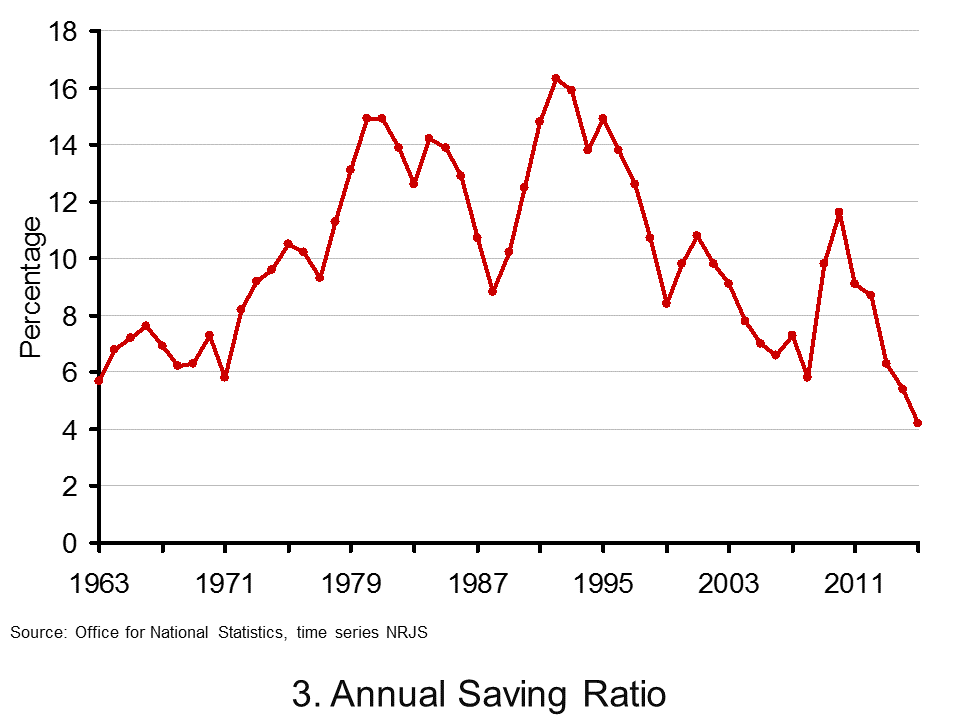 When seen in a more historic context the latest numbers taken on even greater significance. Chart 3 shows the annual saving ratio since 1963. From it we can see that the 2015 value of 4.2 was the first year when the ratio fell below 5 per cent. With 2014 being the previous historic low, there must be some concern that UK consumption growth is not being underpinned by income growth. (Click here to download a PowerPoint.)
When seen in a more historic context the latest numbers taken on even greater significance. Chart 3 shows the annual saving ratio since 1963. From it we can see that the 2015 value of 4.2 was the first year when the ratio fell below 5 per cent. With 2014 being the previous historic low, there must be some concern that UK consumption growth is not being underpinned by income growth. (Click here to download a PowerPoint.)
 Of course, consumption theory places great emphasis on expected future income in determining current spending. To some extent it may be argued that households were liquidity-constrained following the financial crisis. They were unable to borrow to support spending and, as time moved on, to borrow against the expectation of stronger income growth in the future. This would have depressed consumption growth. But, there may also have been a self-imposed liquidity constraint as the financial crisis unfolded. Heightened uncertainty may have led households to be more prudent and divert resources to saving. Such precautionary saving would tend to boost the saving ratio and so may be a factor in the sharp rise we observed in the ratio.
Of course, consumption theory places great emphasis on expected future income in determining current spending. To some extent it may be argued that households were liquidity-constrained following the financial crisis. They were unable to borrow to support spending and, as time moved on, to borrow against the expectation of stronger income growth in the future. This would have depressed consumption growth. But, there may also have been a self-imposed liquidity constraint as the financial crisis unfolded. Heightened uncertainty may have led households to be more prudent and divert resources to saving. Such precautionary saving would tend to boost the saving ratio and so may be a factor in the sharp rise we observed in the ratio.
 The easing of credit constraints as we headed through the early 2010s allied with stronger economic growth may help to explain the strength of the recovery in consumption growth. However, it is the extent and, in particular, the duration of this strong consumption growth that is fuelling a debate over its sustainability. The current uncertainty around future income growth and the need for households to be mindful of the indebtedness built up prior to the financial crisis point to households needing to retain a degree of caution. Consequently, the debates around the financial well-being of households and the need to rebalance the UK economy away from consumer spending are likely to be further intensified by the latest consumption and saving data.
The easing of credit constraints as we headed through the early 2010s allied with stronger economic growth may help to explain the strength of the recovery in consumption growth. However, it is the extent and, in particular, the duration of this strong consumption growth that is fuelling a debate over its sustainability. The current uncertainty around future income growth and the need for households to be mindful of the indebtedness built up prior to the financial crisis point to households needing to retain a degree of caution. Consequently, the debates around the financial well-being of households and the need to rebalance the UK economy away from consumer spending are likely to be further intensified by the latest consumption and saving data.
Data
All data related to Quarterly National Accounts: Quarter 4 (Oct to Dec) 2015 Office for National Statistics
Office for National Statistics Office for National Statistics
Articles
Britons raid savings to fund spending as economists warn recovery ‘built on sand’ Telegraph, Szu Ping Chan (31/3/16)
UK Growth Higher But Deficit Hits New Record Sky News, (31/3/16)
Britain is a nation that has forgotten how to save Telegraph, Jeremy Warner (31/3/16)
A vulnerable economy: the true cost of Britain’s current account deficit Guardian, Larry Elliott (31/3/16)
U.K. Manufacturing ‘In the Doldrums’ Leaves Growth Lopsided Bloomberg, Emma Charlton (1/4/16)
Pound drops as UK manufacturing languishes in the doldrums Telegraph, Szu Ping Chan (1/4/16)
Questions
- Why is the distinction between nominal and real growth an important one when looking at many macroeconomic variables.
- Examine the argument that the historic low saving ratio in the UK is a cause for concern.
- What factors might we expect to impact on the saving ratio?
- To what extent do you think the current growth in consumer spending is sustainable?
- How important are expectations in determining consumer behaviour?
- Explain what you understand by consumption smoothing.
- Why would we would typically expect consumption growth to be less variable than that in disposable income?
- Why might consumption sometimes be observed to be less sensitive or more sensitive to income changes?
- What factors might cause households to be liquidity constrained?
- What is precautionary saving? What might affect its perceived importance among households?
 What have been, and will be, the monetary and fiscal responses to the Brexit vote in the referendum of 23 June 2016? This question has been addressed in speeches by Mark Carney, Governor of the Bank of England, and by George Osborne, Chancellor the Exchequer. Both recognise that the vote will cause a negative shock to the economy, which will require some stimulus to aggregate demand to avoid a recession, or at least minimise its depth.
What have been, and will be, the monetary and fiscal responses to the Brexit vote in the referendum of 23 June 2016? This question has been addressed in speeches by Mark Carney, Governor of the Bank of England, and by George Osborne, Chancellor the Exchequer. Both recognise that the vote will cause a negative shock to the economy, which will require some stimulus to aggregate demand to avoid a recession, or at least minimise its depth. However, since the vote he is now saying that the slowdown would force him to extend the time for reaching a surplus beyond 2019-20 to avoid dampening the economy further. But does this mean he is abandoning his fiscal target and resorting to discretionary expansionary fiscal policy?
However, since the vote he is now saying that the slowdown would force him to extend the time for reaching a surplus beyond 2019-20 to avoid dampening the economy further. But does this mean he is abandoning his fiscal target and resorting to discretionary expansionary fiscal policy? Statement from the Governor of the Bank of England following the EU referendum result Bank of England (24/6/16)
Statement from the Governor of the Bank of England following the EU referendum result Bank of England (24/6/16) Uncertainty, the economy and policy – speech by Mark Carney Bank of England (30/6/16)
Uncertainty, the economy and policy – speech by Mark Carney Bank of England (30/6/16) Introduction to Financial Stability Report, July 2016 Bank of England (5/7/16)
Introduction to Financial Stability Report, July 2016 Bank of England (5/7/16) Osborne: Life will not be ‘economically rosy’ outside EU BBC News (28/6/16)
Osborne: Life will not be ‘economically rosy’ outside EU BBC News (28/6/16) Osborne takes ‘realistic’ view over surplus target BBC News (1/7/16)
Osborne takes ‘realistic’ view over surplus target BBC News (1/7/16) Why has George Osborne abandoned a key economic target? BBC News (1/7/16)
Why has George Osborne abandoned a key economic target? BBC News (1/7/16)
















